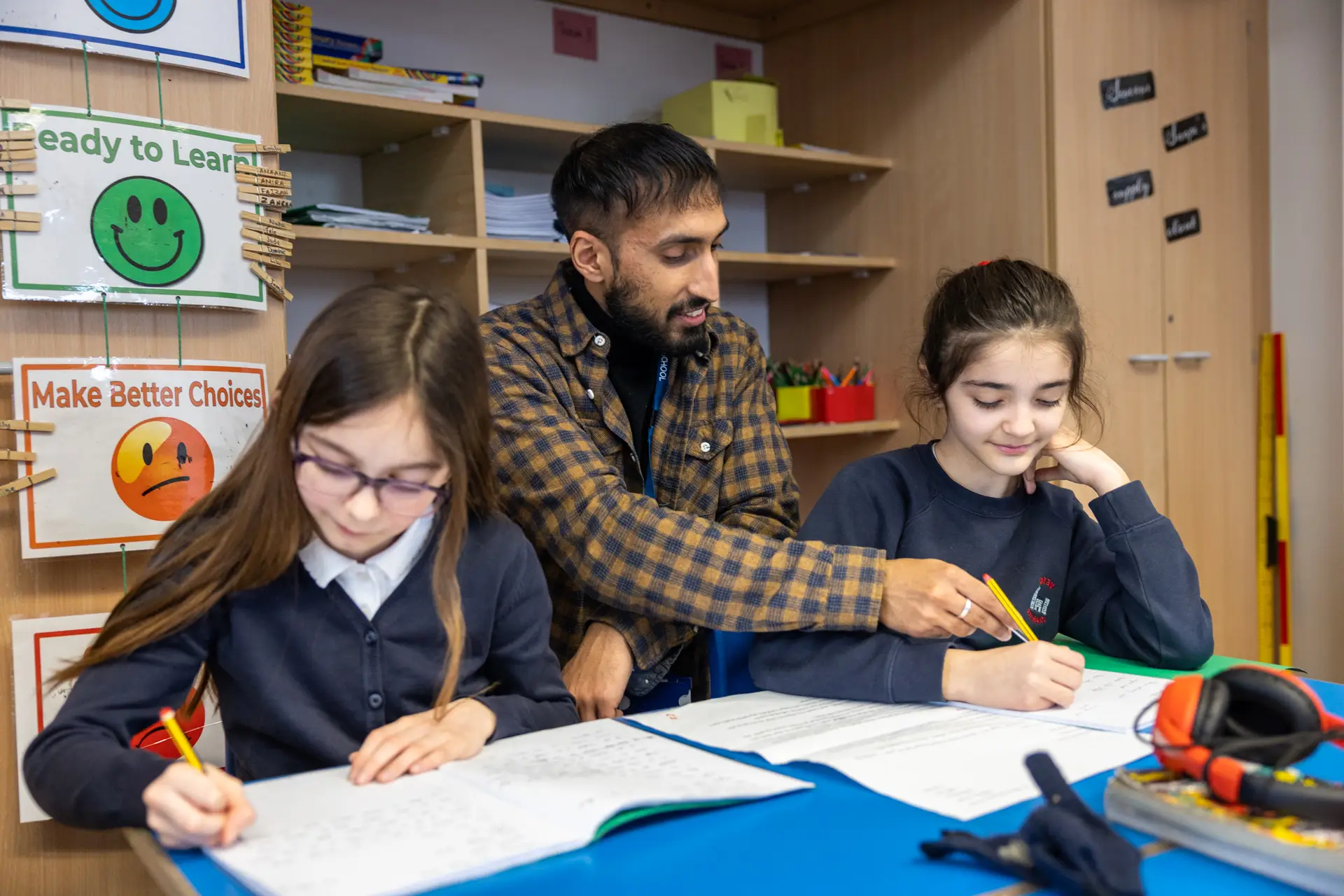Composition is what brings writing to life. When you help pupils understand how the writing process works, you set them up to be confident, capable writers.
This article explores why the writing process matters for pupils, how breaking writing into clear steps helps build confidence, and what effective teaching looks like at each stage. You will find practical strategies for guiding pupils through planning, drafting, editing, proofreading and sharing. Plus get prompts to help you reflect on your current approach to teaching writing.
Writing is a journey, not a sprint
When you think about writing in the classroom, it is easy to picture the finished piece – a story, an essay or a letter. The Department for Education’s writing framework highlights that writing is much more than putting words on a page. Effective writing involves moving through several stages of composition. Each stage gives pupils the chance to shape their ideas, organise their thoughts and refine their language.
Teaching the steps of composition – rather than treating writing as a single activity – makes a real difference (Breadmore, 2019; Education Endowment Foundation (EEF), 2021). When you teach these processes explicitly, you help pupils manage each stage and improve the quality of their writing (Graham, 2012).
However, it is important to recognise that writing is not a straightforward, step-by-step process. Pupils often move back and forth between stages as they refine and develop their work (Quigley, 2022). One approach is to ensure that editing and revising take place throughout the writing process, not just at the end. Using strategies like ‘editing stops’ and ‘editing teams’ makes editing more manageable and collaborative for pupils. With clear support and regular opportunities to review their work, pupils build confidence and develop as independent, capable writers (Quigley, 2024).
Stage one: Planning
Planning is where writing begins. Pupils set goals, build on what they know, gather information and explore model texts. Effective planning clarifies purpose and audience, and gives direction. Research shows a clear link between the quality of writing and the amount of planning pupils do (Hayes, 1996).
Your role is to teach pupils why planning matters and how to approach it. Support them to plan their own writing (Education Endowment Foundation, 2019) by jotting down ideas, key vocabulary and possible sentence structures. You can use graphic organisers, mind maps or planning grids to help pupils organise their thoughts, as different tools suit different tasks (Quigley, 2022).
It is helpful for pupils to understand that a plan is not fixed: they should use their plan actively as they write, and adapt and change it as their ideas develop.
Reflection prompts:
- How do you ensure that pupils have enough time and support to organise their ideas before they start writing?
- What strategies do you use to introduce different planning tools, such as graphic organisers or mind maps?
Action steps:
- Encourage pupils to jot down ideas and key vocabulary – get pupils to note possible sentence structures before they begin writing.
- Check in with pupils during drafting – support pupils to monitor and adjust their plans as their ideas develop.
Stage two: Drafting
Drafting is when pupils turn their planned ideas into sentences and paragraphs. The aim is to get ideas onto the page, rather than focus on perfect spelling, punctuation or handwriting. Encourage pupils to talk through their sentences before writing or use prompts and sentence starters to help them begin.
Model the drafting process by thinking aloud, for example by showing how to expand a simple sentence or link ideas together. Give pupils time to write freely and remind them that their first draft does not need to be perfect – they can make changes as they go and adapt their writing to fit their plan.
Reflection prompts:
- How do you model the drafting process, and do you make your thinking visible to pupils?
- How do you give pupils time and freedom to experiment with language and structure when they write their first drafts?
Action steps:
- Promote modelling and think-aloud strategies across teaching teams - regularly demonstrate the drafting process, make thinking visible and show how sentences and ideas can be expanded and connected.
- Create a culture where first drafts are valued as a starting point – give pupils time for free writing, emphasising that drafting is about experimenting and learning.

Stage three: Revising
Revising means improving the content and quality of writing – changing structure, tweaking sentences or choosing better words. Support pupils by modelling revision, practising on anonymised samples and reminding them that first drafts are rarely perfect. Encourage pupils to re-read, add detail, and think about their audience and purpose. Pupils may need feedback at first, but the goal is for them to use revising strategies independently (EEF, 2021).
For younger pupils, revising often means making simple changes, such as adding words or checking for sense. They need plenty of support, and completing a first draft is a big achievement. In Key Stage 2, give pupils time to review and improve their own and others’ writing. They can spot ways to make their writing flow better, such as adding cohesive devices. These might include linking words and phrases like ‘however’, ‘as a result’, or ‘in addition’. Use checklists to help them manage the process and keep track of what to look for.
Reflection prompts:
- How do you model the revising process for pupils?
- How do you provide pupils with enough time and support to make meaningful improvements to their drafts, considering the needs of their audience and purpose?
Action steps:
- Establish regular opportunities to model revision strategies – use anonymised writing samples and think-aloud techniques, so pupils see how to make meaningful improvements to their work.
- Ensure pupils have time and tools for revision – build in time for re-reading and reflection, and provide resources such as checklists to help pupils review and improve their writing independently.
Stage four: Editing
When pupils edit, they check for mistakes in spelling, punctuation and sentence structure, and aim to make their writing clearer. Effective editing relies on pupils having a good grasp of these technical skills, so guide them through this process.
Model how to use spelling strategies and show pupils what to look for when they edit their own writing. It is useful to let pupils practise editing anonymous writing first, as this gives them a low-stakes way to build their skills before tackling their own work. When they are new to editing, pairing pupils up or having them read their work aloud can also help.
Introduce editing from Year 2 onwards. Support pupils to spot and correct errors, review writing together and use editing symbols. In Key Stage 2, pupils should proofread their work for spelling, grammar and punctuation errors on their own. An editing checklist and regular editing stops during drafting help pupils remember what to check and make the task more manageable.
Reflection prompts:
- How do you model effective editing for pupils, including using spelling strategies and editing symbols?
- How do you make editing a regular part of the writing process without making it overwhelming for pupils?
Action steps:
- Model editing strategies and provide practice with anonymous writing – show pupils how to spot and correct errors and give them opportunities to edit sample texts before working on their own writing.
- Introduce editing checklists and regular editing stops – use checklists to guide pupils’ proofreading and break editing into manageable chunks during drafting, helping them build independence and accuracy over time.
Stage five: Sharing
When pupils know their writing will be read or heard, they start to see that writing has a real purpose (Bazerman, 1994). Sharing does not have to be complicated. It could be as simple as pupils writing their final version knowing you are looking forward to reading it, reading their work aloud to the class, or sharing it with peers and families.
Sometimes, you might go further and publish blogs, send letters or emails to headteachers or local politicians – especially when a response is expected. Formal publishing, where writing is accessible to a wider audience, can be powerful, but it shouldn’t take away from the time spent teaching and developing writing. What matters is that pupils get varied opportunities to produce purposeful writing (EEF, 2021).
Reflection prompts:
- What opportunities do you provide for pupils to share their work, both informally and formally?
- How do you make sure pupils experience a range of purposeful writing tasks, from sharing with classmates to publishing for a wider audience?
Action steps:
- Create regular opportunities for pupils to share their writing – encourage sharing in different ways, such as reading aloud in class, displaying work, or sharing with families and peers.
- Provide choice in sharing formats – offer pupils a range of ways to present and share their writing, such as posters, digital presentations, audio recordings or performances, so they can find formats that suit their strengths and interests.
This explainer is part of a series for teachers and school leaders on how to navigate the writing framework. Explore the other articles.
References
- Bazerman, C. (2017) 'What do sociocultural studies of writing tell us about learning to write', in MacArthur, C. A., Graham, S. W. and Fitzgerald, J. (eds) Handbook of Writing Research. New York: Guilford Press, pp. 11-23
- Breadmore, H. L. (2019). Literacy development: evidence review.
- EEF. (2021). Improving Literacy in Key Stage 2. Guidance Report
- Graham, S. M. (2012). A meta-analysis of writing instruction for students in the elementary grades. Journal of Educational Psychology, 104(4), 879–96.
- Hayes, J. R., & Nash, J. G. (1996). On the nature of planning in writing. In C. M. Levy & S. Ransdell (Eds.), The science of writing: Theories, methods, individual differences, and applications (pp. 29–55). Lawrence Erlbaum Associates, Inc.
- Quigley, A. (2022). Closing the Writing Gap. Routledge.
- Quigley, A. (2024). Writing and the final mile problem. Retrieved from https://alexquigley.co.uk/writing-and-the-final-mile-problem/
- Whitaker, D., Berninger, V., Johnston, J. and Swanson, H.L. (1994) 'Intraindividual Differences in Levels of Language in Intermediate Grade Writers: Implications for the Translating Process', Learning and Individual Differences, 6(1), pp. 107-130.



